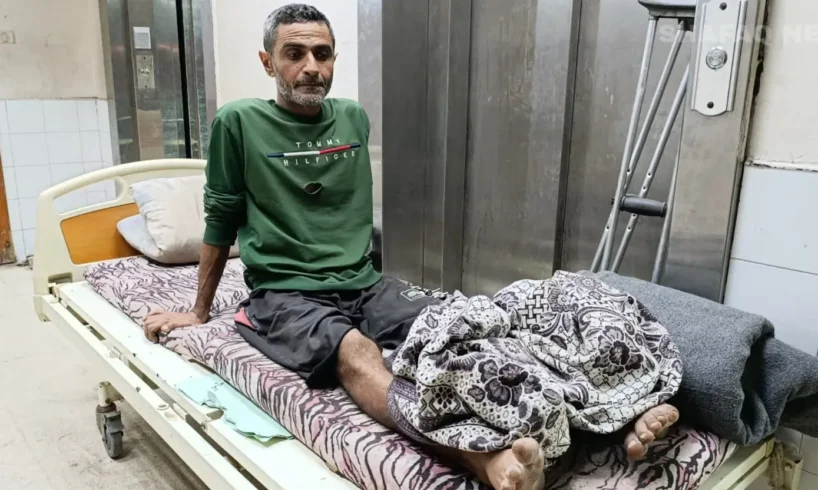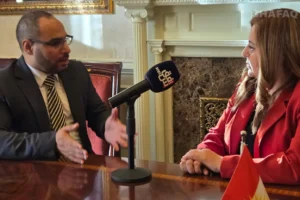
Shafaq News
After the guns fell silent, Gaza’s
hospitals remain crowded with the war’s living casualties—men, women, and
children who survived the explosions but now face a new, quieter war: the
struggle to live with permanent disability in a territory where the health
system has collapsed.
Eyad Rajab al-Tawashi, 37, was shot
in the ankle last August while walking toward the Zikim crossing in search of
food for his family. “No facility has been able to treat my case or even
provide a joint replacement,” he told Shafaq News from his bed in Al-Aqsa
Martyrs Hospital.
His wound, untreated for months, has
now become disabling. “I can’t even reach the bathroom, yet I’m not eligible
for a wheelchair,” he said, explaining that the World Health Organization (WHO)
distributes them only to amputees or fully paralyzed patients. Once the
family’s provider, he now relies on food parcels from aid agencies.
Al-Tawashi’s story captures a
broader humanitarian emergency: thousands who survived the 2023–2024 war only
to be trapped in long-term medical neglect.
According to Gaza’s Ministry of
Health, at least 170,200 people have been injured since October 7, 2023. The
World Health Organization estimates that around 42,000 of those injuries are
life-altering—including 5,000 amputations, 2,000 spinal injuries, and 1,300
brain injuries.
Facilities that once offered
physiotherapy and prosthetics have been bombed or rendered inoperable by power
cuts and supply shortages. Doctors now work in tents or corridors. “We used to
measure recovery in months,” said a surgeon at Al-Shifa Hospital, requesting
anonymity. “Now we measure how long a patient can survive without painkillers.”
Humanitarian organizations report a
rise in “secondary disabilities”—injuries that could have healed if treated
promptly but became permanent due to infection or delayed surgery.
A Euro-Med Human Rights Monitor
assessment in May 2025 found that about 30 Palestinians become permanently or
temporarily disabled every day, bringing the total to more than 21,000 people
since the start of the war, including 4,800 amputees and 1,200 cases of
paralysis.
The UN Committee on the Rights of
Persons with Disabilities (CRPD) estimates that 21,000 children have been newly
disabled, and that Gaza now hosts around 90,000 people with disabilities
overall, roughly 4 percent of the enclave’s population.
Even after the ceasefire, Israel’s
continuing restrictions on medical evacuations have left thousands unable to
access treatment abroad. According to UN OCHA data (September 2025), fewer than
12 percent of medical-transfer requests from Gaza were approved during the
first half of the year—one of the lowest rates since 2014.
The Palestinian Ministry of Health
accuses Israel of “weaponizing medical access,” while Israeli authorities cite
“security vetting” procedures. The closure, compounded by internal political
division between Hamas and the Palestinian Authority, has frozen most foreign
rehabilitation programs.
“The blockade doesn’t only stop
goods—it stops recovery,” said a Gaza health worker.
Meanwhile, UNRWA figures show that
rehabilitation projects represent less than 6 percent of total humanitarian
funding to Gaza since the war—underscoring a global aid gap that prioritizes
temporary shelter over long-term recovery.
For Gaza’s children, disability
carries a lifetime of consequences. “We are watching a generation learn to
crawl again on makeshift limbs made from plastic pipes,” said a nurse working
in central Gaza.
The Save the Children organization
warned in its June 2025 report that child amputations in Gaza have reached
record levels, with more than 2,500 children losing one or more limbs.
Psychologists describe an emerging “orphaned generation”—not without parents,
but without opportunity. Schools lack accessible infrastructure, and trauma
counseling is almost nonexistent.
“The war created visible ruins,”
said Gaza-based psychologist Ahmad Abu Warda. “But the invisible ones—mental
trauma and physical disability—will shape Gaza’s future far longer.”
Before the war, Gaza’s unemployment,
according to the World Bank, stood at 45 percent. Now, with thousands of
workers disabled and hundreds of factories destroyed, the Bank’s mid-2025
assessment warns of a “collapse in labor participation” and a GDP contraction
of more than 25 percent compared with prewar levels.
Read more: Two years of Israeli war leave Gaza in ruins
“Disability in Gaza is not only
medical—it’s economic,” said economist Osama Hamdan. “A father who loses a leg
also loses his job, his home, and his role in society. Multiply that by tens of
thousands, and you have a social fabric on the brink of disintegration.”
Families now sell belongings to
purchase mobility aids on the black market, where a single wheelchair costs
$700–$1,000, according to Human Rights Watch estimates. Others use grocery
carts or wooden boards as improvised substitutes. In a UN field survey (August
2025), 78 percent of disabled respondents said they had no income and no access
to assistive devices.
While aid agencies have documented
the crisis, few have developed a coherent rehabilitation plan. The WHO has
described the situation as a “mass-disability event” that will require decades
of sustained intervention.
Read more: WHO alarms disease spread in Gaza spiraling beyond containment
European and Arab donors have
pledged mobile clinics and field hospitals, but these address acute injuries,
not the chronic needs of amputees or the psychologically scarred.
“Rehabilitation is invisible aid—it doesn’t make headlines,” one NGO official
said.
For many Gazans, the ceasefire
changed only the soundscape, not the suffering. Eyad al-Tawashi’s days now pass
between hospital corridors and silent waiting. He holds a photo of his children
in his hand—the same hand that once pushed their swing. “They call it a
ceasefire,” he said quietly. “But for us, the war never ended.”
Written and edited by Shafaq News
staff.





